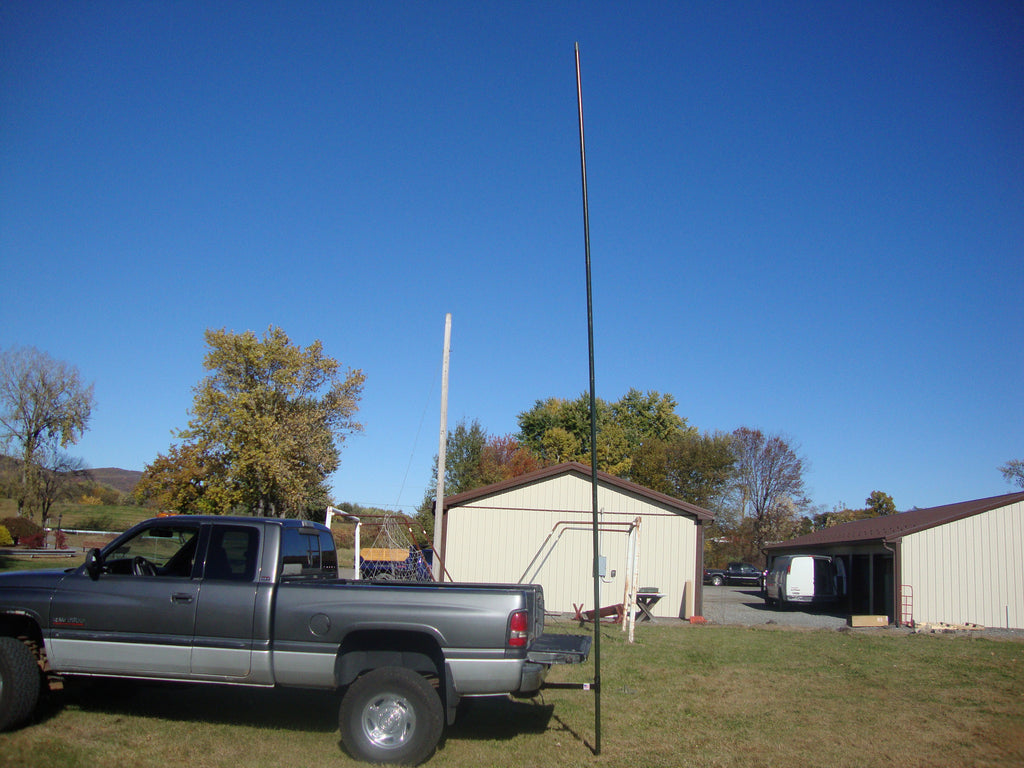A 2-meter mobile radio and magnetic mount antenna are adequate for rally use, but can still be tricky to use on remote stages. You may have to park your car very carefully to place your antenna in a hot spot for reception. Changing conditions can move that hot spot, which is quite inconvenient when it happens while a stage is running!
Fortunately, it’s cheap and easy to set up a larger antenna on a portable mast. While not quite as convenient as parking and going straight on the air, a little height can go a long way toward improving communications reliability, particularly on remote stages.
The Mast

This mast uses military surplus fiberglass poles originally intended for camouflage netting. These are available on MilitaryFieldGear.com for $41.99 for a 12-pack. Use as many or few four-foot sections as you need to place your antenna as high as you want it, up to 48 feet. Keep in mind that you will probably need to add guy wires to the mast above a certain height, but even 20 feet of elevation will be 20 feet more than you had before.
Aluminum poles are also available but are not recommended. Not only could they affect antenna radiation patterns, they also present an electrocution risk if any wires happen to be around!
The Base

There are any number of solutions for securing the base of your antenna. One is a tripod mount like this. Use three of your fiberglass poles as legs, then slide another for your mast through the center. The mast will then support itself.
If you have a 2-inch receiver hitch, you could consider this hitch mount. The vehicle becomes the support for the mast, which is less likely to blow over in the wind than a self-supporting structure.
You can also make your own base using a piece of plywood, a 2-inch pipe flange, and a section of threaded pipe. The idea is that you park your car with one tire on top of the plywood and the flange sticking out to the side. Screw in the pipe, then slide the bottom section of mast inside the pipe. Again, the vehicle becomes the support for the mast.
The Antenna

Of course, you’ll need an antenna for the top of your mast. J-poles are very popular and effective choices. The bottom section, below the J, is not a part of the antenna as far as radio waves are concerned so you can clamp this directly to the top section of your mast. They don’t require a groundplane, so no radials are necessary (though improved performance is possible with a ground rod and wire). A J-pole antenna for the 2-meter band is 69 inches long, which can fit in the back of a truck or SUV. A breakaway version is also possible, where the main element splits in two for easier transport.
J-poles are easy to build yourself. Though TV twin-lead isn’t anywhere as near as common as it used to be, you can easily build a J-pole out of it. If you’re not so mechanically inclined, KB9VBR sells pre-built J-poles for very reasonable prices. His standard 2-meter J-pole is $34, with a breakaway version selling for $39.
A variation on the J-pole that KB9VBR offers is the Slim-Jim. This design turns the main element of a J-pole back on itself, making it a folded dipole instead. This design has more gain and a lower radiation angle than a standard J-Pole, and is only 58 inches long. One disadvantage is that it works best at higher elevations above the ground, which may not always be possible. KB9VBR sells Slim-Jims in standard form for $45 and breakaway form for $54.
Coax
This may go without saying, but for the sake of completeness, don’t forget to bring enough coax to run between your hoisted antenna and your radio! You’ll want RG-58, with a PL-259 connector on one end to plug into your radio and whatever the antenna uses on the other end. if you use an SO-239 connector on the antenna you can use PL-259 on both ends of the coax to make life easier.
Conclusion
You certainly don’t need a mast to work rally communications. But it can help, and as you can see it isn’t too difficult or expensive to put the components for one together. This system is fast and easy to set up and take down, which is especially handy if your stage crew works more than one location in a day. It’s also quite flexible, allowing you to change the height of your antenna by adding or removing mast sections. Not only will your signal get out better from an antenna on a mast, you’ll also have an easier time hearing everyone else. A little height goes a long way.


Great readinng your blog post
LikeLike